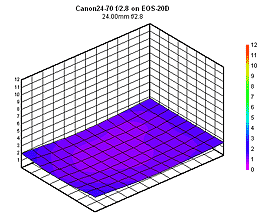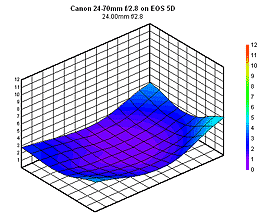Canon EOS-5DBy: Dave EtchellsSlightly smaller and lighter upgrade brings greater speed and ease of use along with higher res and lower image noise. <<Viewfinder :(Previous) | (Next): Exposure & Flash>> Page 5:OpticsReview First Posted: 04/02/2006 |
Optics
The Canon EOS 5D accepts Canon's standard EF lenses, but is not compatible with the newer EF-S lenses, designed for cameras with smaller sensors. Key features of the Canon EF lenses are the exceptionally fast, silent "ultrasonic" focusing mechanism (a coreless motor built into the lens body itself) found on some models, and the exceptional range of optically stabilized models that permit hand-holding way beyond light levels that would normally require the use of a tripod. Unlike most digital SLRs, the sensor in the EOS 5D is about the same size as a 35mm film frame. This means that the "effective" focal length of your lenses will actually be the same as their normal values on 35mm cameras. Great news for anyone who already has a nice collection of Canon EF lenses, particularly if they favor a really wide-angle photography.
As we noted earlier though, the full-frame digital sensor imposes much more stringent requirements on lens quality than do the smaller APS-C sized sensors used in the EOS-20D and Digital Rebel cameras. Most lenses have a harder time producing crisp, distortion-free images near the edges of their image circles than they do near the center of the frame. This means that digital SLRs with sub-frame sensors use only the "sweet spot" in the center of the frame when they're paired with a lens designed for full-frame coverage, resulting in better image quality than might normally be associated with the lens. The Canon 5D has no such luxury though, as its high resolution digital sensor goes right out to the edges of the 35mm frame. The large physical size and high resolution of the 5D's digital sensor combine to create a real torture test for lenses. If a lens has the slightest tendency towards softness, chromatic aberration or distortion in the corners of the 35mm frame, the 5D's sensor is going to make the optics' shortcomings glaringly obvious. It's worth repeating: The Canon EOS-5D is not the camera to buy if you don't also have the budget necessary to acquire absolutely first-rate lenses.
The 5D has an autofocus system with nine main sensors, arrayed in a diamond pattern in the center of the frame. You can manually select which of these you want the camera to pay attention to (handy for off-center subjects), or you can let the camera decide. When it's operating in automatic AF mode, it will use the sensor corresponding to the part of the subject closest to the camera. The 5D's AF system operates in One Shot, AI Focus, or AI Servo AF modes. One Shot mode simply sets focus for each individual shot, while AI Servo AF tracks the subject as it moves. Through the Custom settings menu, you can expand the 5D's AF point selection area for AI Servo AF mode, and add six invisible AF points within the spot metering circle. Essentially, you'll have seven AF points tracking a moving subject instead of only one, which is very useful for erratic movements. AI Focus AF automatically flips between One Shot and AI Servo AF modes, depending on the subject. The 5D also offers what Canon terms "Predictive AF," which basically calculates the rate at which a subject is approaching or receding from the camera, and then accurately focuses based on the subject's predicted position. (A feature that sports photographers will no doubt appreciate.) Manual focus is also available with any Canon EF lenses, simply by sliding the AF/MF switch on the lens barrel.
Full-frame vs APS-C: How big a difference?
We mentioned above that the full-frame sensor of the 5D (or for that matter of the 1Ds Mark II) is much more demanding of lenses used with it. This should be very much a factor in deciding between a high-performance sub-frame camera (like the Canon EOS-30D or Nikon D200) and a full-frame model like the Canon 5D. While you can certainly use any lens with a full-frame image circle on the 5D, it's going to be merciless in showing off the faults of lesser optics, particularly in the corners of the frame. If you really care about image quality (and you probably do, or you wouldn't be considering spending the amount of money a 5D commands), buying a 5D will also amount to a commitment to buying and using only the best (and therefore most expensive) lenses with it. In the Canon line, this means "L" glass, and in fact Canon themselves recommend only L-series lenses for use with their full-frame d-SLRs, the 5D included. If you plan on owning more than one or two lenses, the cost of the glass to support the 5D's capabilities will ultimately far outstrip the cost of the camera.
 |
| Canon 24-70mm f/2.8L on 20D (Click to view full results) |
 |
| Canon 24-70mm f/2.8L on 5D (Click to view full results) |
To see what we're talking about here, the images at right are links to interactive lens-sharpness viewers, as seen on our sister site, SLRgear.com. Clicking on either image will launch an interactive viewer in a separate window. Based on data from hundreds of test shots in our lab, the 3-D graphs plot lens blur across the frame, at a range of focal lengths and apertures. - You can adjust the focal length and aperture with sliders on the viewers, to see how the sharpness varies with different settings. Both viewers show the same lens (the excellent Canon 24-70mm f/2.8 L), the only difference being the camera they're being used on. The viewer on top shows results measured on an EOS-20D body, the viewer on the bottom shows the results with an EOS-5D.
This is a truly excellent lens by any measure, but on the 20D it's simply outstanding, delivering extremely sharp images across the full image area from 24-50mm, finally softening a bit its maximum focal length of 70mm. While still very good, results on the 5D aren't nearly as good in the corners of the frame, particularly at 24 and 70mm. Now keep in mind that this is a lens that's currently (early 2006) retailing for around $1,200. Typical $300-500 zooms are going to look much, much worse.
There's also the matter of bulk when considering lenses for a full-frame d-SLR. The 24-72mm f/2.8 L optic we've just been discussing is a huge, heavy hunk of glass. The reduced image circle of cameras like the 30D and Rebel series allows lenses to be made much smaller for similar optical characteristics. Canon themselves have been steadily rolling out more and more EF-S lenses over the last couple of years, and it seems very likely that they'll continue to do so. Third-party makers are also jumping on the reduced image-circle bandwagon, with Sigma being particularly aggressive in this area. - And a smaller image circle doesn't necessarily imply low-quality glass either: Canon's little 10-20mm super-wide angle EF-S lens is absolutely top-notch in its performance.
Of course, there are other advantages of the larger image sensor, namely higher resolution without paying a noise penalty for smaller sensor pixels in the process. The larger sensor also has a 1:1 crop factor, so if you currently own a number of wide-angle lenses, they'll continue to take in their full field of view on the 5D body. (Not to belabor the point though, but you could also purchase a 30D and the Canon 10-20mm EF-S super-wide zoom, for considerably less than the cost of the 5D body alone.)
Reader Comments! --> Visit our discussion forum for the Canon EOS-5D!

Follow Imaging Resource: